 |
| Farewell to Ryokan |
There was calm in our hearts as we left the ryokan for a day that turned us into feast fans. Every meal and adventure takes us to places where we never dreamed we would go. We started with a visit to Nijo Castle, which was the first official residence of the Tokugawa Shogun, Iemitsu, built in 1626. The place
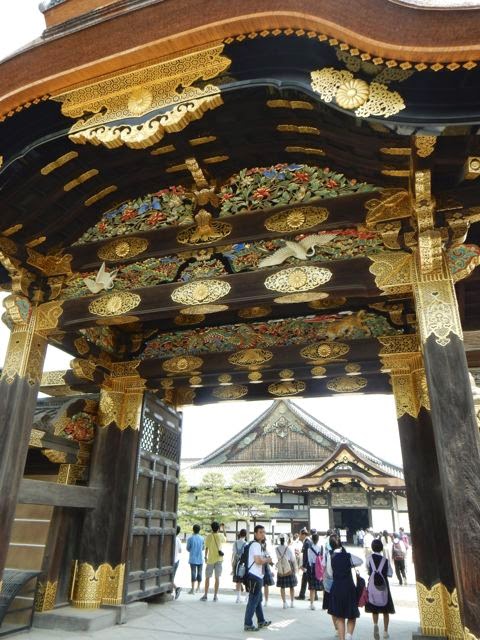 |
| Shogun castle |
was packed with youth on summer break, arriving in bunches in their school uniforms, but most interesting were their backpacks, hanging low, in a range of patterns from Mickey Mouse ears to frothy French baroque flower patterns. After removing our shoes, we entered the single story spacious main residence where the Shogun held sway in days of yore. The “nightingale effect” from so many shoe less feet walking across the beautiful wooden floors was entertaining here (sounds like birds chirping.) Each large space was empty of furniture and clutter but with screens and walls ornately painted in gold to reflect the sunlight – since there was no electricity in those days – and each space had a political purpose: the military officers and enemies and political plunderers met in one large room where the Shogun was raised on a dais to emphasize he was better than all; visitors who could arrive with their short Waki-sasha swords (used in hari-kari situations when embarrassment led them to admirable suicide so as not to taint anyone else), but not the long fighting ones.
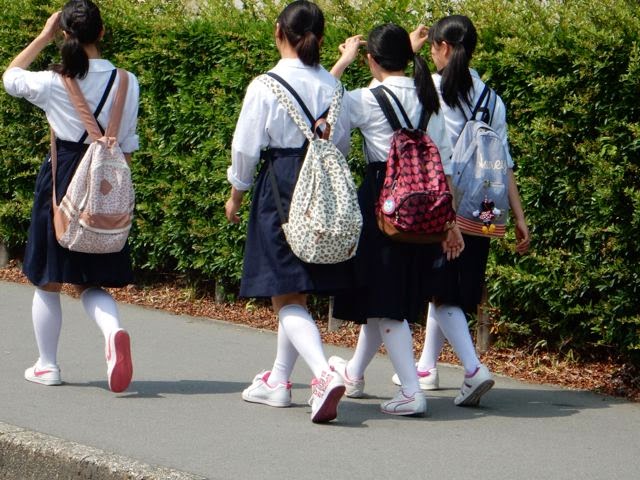 |
| backpack craze |
There was not one reference to a female presence in the old days until we walked around many corners (this place was packed like a Disney sight and we followed in a line) to reach the Shoguns bedless sleeping quarters. There, in model form, two women in fancy kimonos, were shown awaiting on the favors and needs of the Shogun. This was not a woman’s home. Servanthood was their use, and I guess their beauty offered some delight. In the Shogun eras, there was an hierarchy: At the top was the Emperor, just above the single Shogun.. Below him was the Daimyos or feudal lords who answered to the Shogun. And below the Daimyos were the Samurai who worked for the Daimyos and as a side note, on this level, were the Ninjas, who were hired assassins.
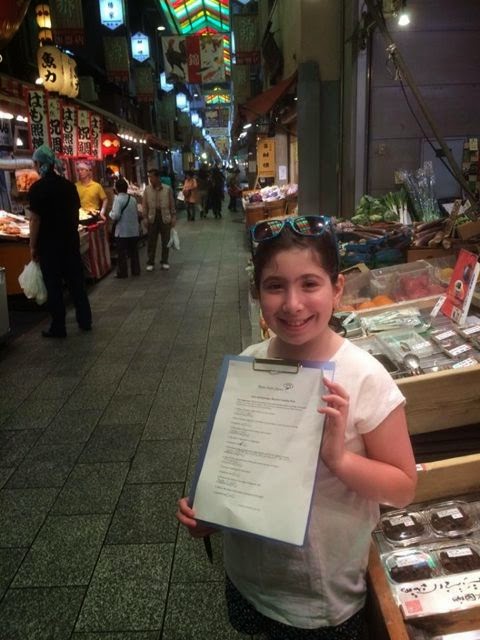 |
| A Scavenger Hunt |
We left the castle and headed to the oldest food market Nishiki ichiba, started 400 years ago, and is a slick, clean, almost meditative long covered street of the best of food and its accessories, like famous Japanese knives. Vegetables unique to Kyoto are called Kyo Yasai, and don’t look like anything in our edible checklist – try Kamaboko or fish cakes of all shapes and sizes, and Tsukemono or Japanese pickles, which accompany rice everywhere it goes. But Caroline was given an 18 question scavenger hunt so that she would learn much about the market, like what type of flour is used for soba noodles, find 3 foods she had never seen at home (Japanese spinach, bonito flakes and the black pepper green berries); Name two types of green tea – Sincha and nacha. She aced the test. And I purchased 3 special Japanese knives which need more care than a diamond.
 |
| Kyoto spinach |
Next on our agenda was a cooking school. But we had the choice delight of going to a typical small restaurant (there are no large ones), which seats 13 people at a long bar-style, where the client watches everything the chef does in preparation and usually by himself. This chef who owns YUBI Restaurant, was a young man who had spent time learning the skills of Parisian cookery and had returned to make an art of food out of Kyoto’s unusual selection of products. He had closed his restaurant this day for lunch to teach us about Japanese cooking. Caroline and James were incorporated to do the labor to prepare for a Kiseki style meal, one with many offerings – stringing beans (that’s hard), slicing a raw trout to be used for sashimi, learning how to make tofu from soy milk and liquid magnesium, and, of course, preparing, washing and steaming rice. The chef told us that no rice is supposed to be left in a bowl, because each grain of rice has a spirit. If one cannot eat all of it, they preserve it to make rice balls. In a Kaiseki meal, all the ingredients are local. It’s
 |
| Slicing Trout |
considered a banquet style or in the tea ceremony meal it can take up to four hours to consume. We were doing a short version.
This chef’s speciality is the “dashe” or bonito broth. There was a salad of string beans, sliced mushrooms and a sesame paste that Caroline put together herself, watching the chef artistically place each small piece. Japanese meals are not large plates of over-kill helpings, but small elegant pottery shapes and bowls with a small artistically arranged offering. It takes time to prepare. No fast food here (although there is an abundance of Macdonalds and Starbucks in Japan.) We learned how to properly slice vegetables and fish and how to quick fry what we used to consider tempura in a lightweight powder and cotton flower oil; and we engaged in a dessert like nothing i’d ever seen – sort of a rolling jelly dusted in soybean flour called Warabi Mochi. Wasn’t easy to handle with chopsticks, but it certainly entertained the taste buds.
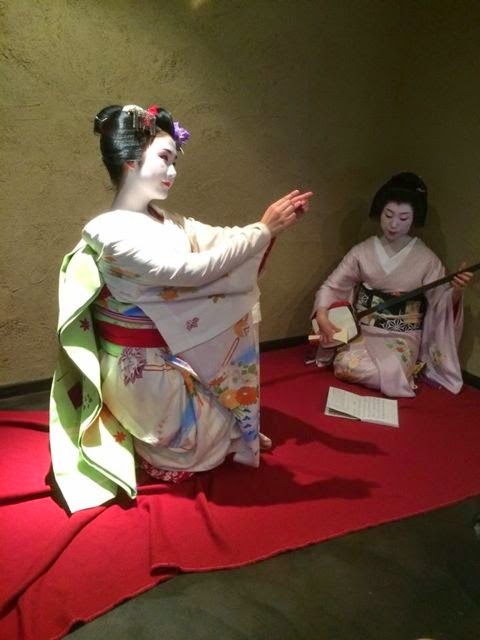 |
| Geisha encounter |
After the meal, we had the special privilege of meeting two Geisha women: they are often a part of tea house experiences and they travel in pairs: the geiko, who is the senior Geisha, and the maiko (dancing child.) They are skilled in the art of conversation, music and beauty. The maiko, apprentice in training, wears the more elaborate kimono with long sleeves and a belt that wraps around many times, and with many ornaments in her hair (it’s still her own hair and not a wig). This , we were told, is because she has not completed the skills of conversation that are primary in the Geisha relationship, and so must be a joy to behold for the time being. The geiko, matured, who can be a Geisha all her life if so desired, often speaks for the maiko, and also wears less ornate and more comfortable kimonos, and most likely a wig, which, she says, is quite heavy. Both paint their faces in the familiar white makeup.
We spoke for about a half hour and asked many intimate questions. The street on which our cooking experience happened is one of the most known streets where Geisha’s live and entertain. It was immaculate and serene and outside the Geisha’s residences were white and red lanterns, signs of their trade which had drawn tourist for years. But now, the streets are nearly empty.
 |
| Ritz Bonsai |
My journalistic skills rose to the surface, curious as I was to learn truths about their lives, but then, these women, the
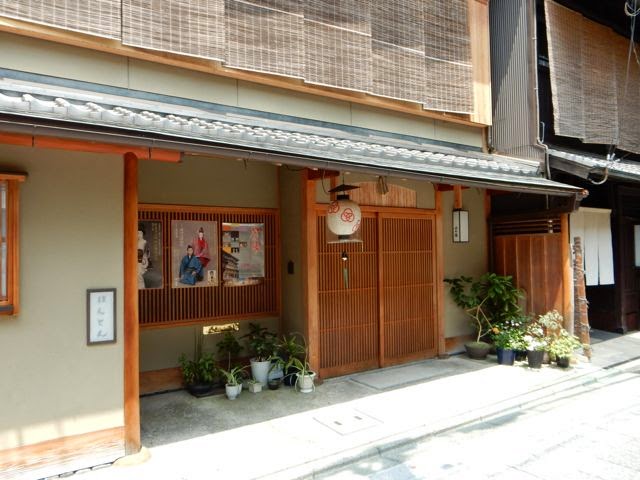 |
| Street of the Geisha |
maiko 19 years old, have chosen this journey with approval of family, almost like going into a nunnery. They can be or become a Geisha for life and at any time in life if they have the beauty and skills. They an also leave, and choose “freedom,” as the geiko said whenever they desire. If they keep their skills, they can even apply to return. There are years and years of training (at least five) and discipline, and above all, these women feel safe in what they do. It is not prostitution, by any means. They are not forced into the brief companionship, but do it by choice. Our geiko actually saw an article in the newspaper about Geishas and applied. It’s being a companion for a few hours and enhancing the man’s appearance by being with such a beautiful and skilled woman. Most play a musical instrument, as our geiko did. The maikos see their families about twice a year, and live under the eye of a house mother.
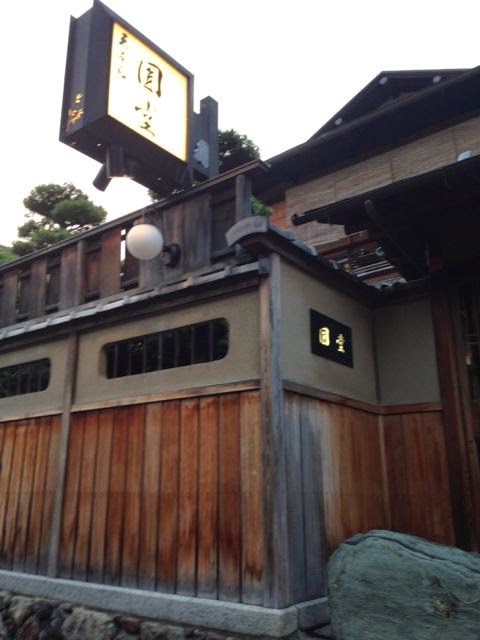 |
| Tempura Restaurant |
Now don’t translate this into things we are accustomed to in America. the Geisha, which is a dying art – dropping fro about 220 in Kyoto to about 75 – but Kyoto Geishas are the trademark of the profession. A maiko is not paid but receives all she needs to live and study her profession. The geiko does get paid and can be in charge of herself and enter a high-cultural world called karyukai (the flower and willow world.) Normally the don’t go shopping and the IPhone is left behind but the maikos do not have them yet. The girls stayed with us awhile as we wandered the beautiful street (Japanese
 |
| Ritz Entrance |
skills in wood and use of space and design is awesome), and they allowed us to take a photograph, which most do not. This experience, woman to woman, I will never forget and I understand more, now, of the drive in their charm.
While all of this was going on, we moved into the new (two months opened) Ritz Carlton which takes Japanese modern architecture and grace into a new high. Once again, the service and attention that spoils us, and a room with a complicated lighting system (fading and unfading) and an splendid view across the river that speaks of the beauty of Kyoto. We had another dinner experience this night – Dinner at a “tempura” restaurant – another long bar (tables and chairs just take up space) where we can interact with the chef. His hand was constantly dipping fish, veggies and other condiments into flour to fry under a huge copper shield and frying apparatus. We had 15 different pieces of tempura and a tiny scoop of green tea ice cream. I wore out about
 |
| Tempura Chef |
piece 10, and was not sufficiently brave to toss down the shrimp heads and another sardine like fish with eye, bones and tail covered in fried crinkles. Sorry, guys.












